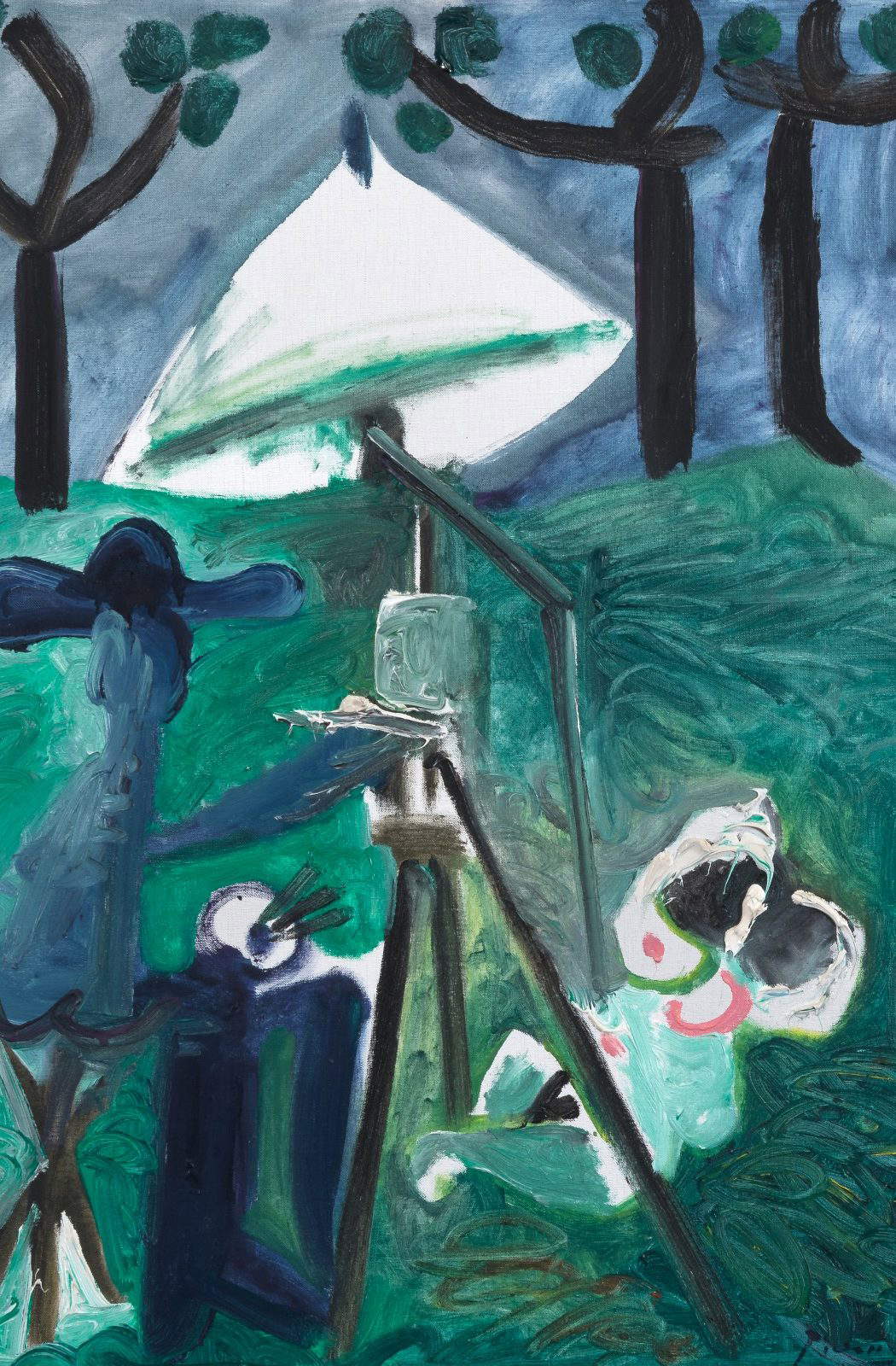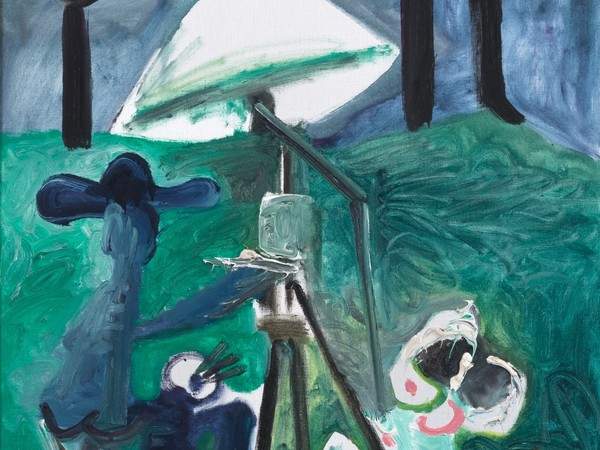Rome, a Picasso painting, Le peintre et son modèle, arrives at Rhinoceros Gallery
Arriving for the first time on display in Rome at Palazzo Rhinoceros is Pablo Picasso ’s painting Le peintre et son modèle en plein air from the Intesa Sanpaolo Gallerie d’Italia - Milan collection. After the great public and press success of the 1909 Young Woman from theHermitage, the Alda Fendi Foundation-Experiments relaunches and proposes a 1963 painting that has never been exhibited in the Capital and is not normally visible to the public. Thus continues the homage to the Malaga genius that anticipates 2023, the “Picassian year” on the 50th anniversary of the painter’s death.
Beginning June 10, 2022, the painting is presented to the public in an exhibition titled Picasso goes, Picasso arrives that is set up at the rhinoceros gallery exhibition spaces inside the rhinoceros building designed by Jean Nouvel, a “neighborhood in the city” dedicated to art and inspired by the Passages of Paris.
Pablo Picasso is therefore once again a protagonist in the heart of monumental Rome, between theArch of Janus and the Palatine: this year, in fact, the Capitoline public was able to admire Young Woman, the portrait of the artist’s inspirational muse and companion, Fernande Olivier, kept at the Hermitage in St. Petersburg. From the breakdown of forms in Young Woman’s analytical cubism, we move on to a meditation on the relationship between the artist and the feminine. The theme, carried by Picasso over the decades, finds in the 1963 painting Le peintre et son modèle en plein air a synthesis that takes on, as Francesco Tedeschi writes, “the poetic values of an encounter with nature, in the idyllic climate of a modern ’pastoral.’”
The work is intended to be the centerpiece of a theatrical installation that revolves around the thousand facets of the Picassian universe. Thinking about the painting activity of the last period of this revolutionary artist beyond his own revolution, Alda Fendi, rebel patron and promoter of this ideal relay between the two paintings, reflects, “Failed artists are out of the game and Picasso experiences the negative, but lashing intoxication of failure before being glorified for his decomposition of the image. Ardent and fiery is his belief in a revolution, never tepid, but pyrotechnic in the hypothesis of a life described in geometric modules, which become poetry seemingly precisely out of the game.”

The painting
Pablo Picasso’s Le peintreet son modèle en plein air, oil on canvas, 1963, belongs to the Intesa Sanpaolo Gallerie d’Italia - Milan collection. The work was purchased by Banco Lariano, later merged into Intesa Sanpaolo, and originally came from Galerie Leiris in Paris, which dealt directly with Picasso’s work in the 1960s.
The depiction of the female nude outdoors, in a natural setting, is a frequent subject in Picasso’s art between the 1950s and 1960s, a variation of the more general confrontation between painter and model that has accompanied his pictorial narrative since the 1910s. The theme constitutes the meeting point between reflection on the painter’s craft, in dialogue with art history, and the representation of the female nude. A challenge, both for the possible solutions in the depiction of poses and their combination with spatial form, and for the meanings intrinsic to the artist’s role.
Le peintre et son modèle en plein air of 1963 continues and echoes the meditations carried out by Picasso between 1960 and 1961 around Manet’s Déjeuner su l’herbe. The artist measures himself against his “masters of choice,” to revise their solutions and reinterpret them in the light of his personal assumption in an “imaginary museum.” Thus the famous subject of Manet’s painting becomes the cue for a disaggregation and re-aggregation of the protagonists, their poses and their role within the composition.
Picasso’s attention is focused around the seated female nude and the man observing her, in a dialogue that is one of complicity and seduction. The background is reduced to the predominant greens and blues, which are almost flattened into a homogeneous space, defined with the characteristic quick and rough strokes of the late Picasso. Only a few hints are needed for the tree canopies, a triangular element for the parasol above the easel, the outline of the hat, more bullfighter than painter. In this simplicity lies Picasso’s ability to transform every gesture into a signifying element.
Around Picasso
The Experiment signed Alda Fendi and Raffaele Curi composes visual and performing arts, ideally bringing together the artist’s two homelands - and two souls - Spain and France. Room after room, the multimedia installation that unravels around Le peintre et son modèle en plein air has a common motif: dance. From the enveloping projections that offer visitors a privileged vantage point on the rehearsal of Miguel Ángel Berna ’s La Templanza for the Ballet Nacional de España, to the disruptive modernity of Pulcinella’s dances. A one-act premiered at the Paris Opera in 1920, the ballet Pulcinella combines the music of Igor Stravinsky with choreography by Léonide Massine for Sergei Djagilev’s Ballets Russes.
Along the exhibition route, a window opens onto the Café de Flore in Paris, while the Picasso colors of Spain caress the faces of viewers. In the black cavern designed by Jean Nouvel, a tribute to one of the greatest contemporary bullfighters, El Rafi (Rafi Racoule), 23, the sixty-ninth French matador de toros. Bullfighting has a historic tradition not only in Spain but also in the south of France, where Pablo Picasso used to witness it with his children Claude and Paloma and friends such as Jean Cocteau. Thus the two souls of Picasso and his two countries, Spain and France, intertwine and merge, and next year they will be united in the celebration of the 50th anniversary of the artist’s death. Of bullfighting, Picasso loved color, gold and folklore, and the great friendship that bound him to the most important toreadors of his time, such as El Cordobés and Manolete, and especially to Luis Miguel Dominguín and his family: Lucia Bosé and his children Lucia, Paola and Miguel Bosé, is well known. In the white cavity, on the other hand, in the presence of the palace’s iconic rhinoceros, an inscription on the wall recalls the words of Neruda. Explaining its connection to Picasso is Raffaele Curi: "It strikes at the heart the amber dust that in the churches of Spain transforms summer into a church of gold. Neruda ’s poetry, which crystallizes a ray into a timeless and ascetic hypothesis, creates the great friendship between Picasso’s ’animus’ and Neruda’s. A friendship theirs that alludes and refers to disruptive scenarios filled with perpendicular light and absolute colors that only summer can give. ’Like summer in a golden church’."
For all information, you can visit the official rhinoceros website.
 |
| Rome, a Picasso painting, Le peintre et son modèle, arrives at Rhinoceros Gallery |
Warning: the translation into English of the original Italian article was created using automatic tools. We undertake to review all articles, but we do not guarantee the total absence of inaccuracies in the translation due to the program. You can find the original by clicking on the ITA button. If you find any mistake,please contact us.




























